It's all about the classical music composers and their works from the last 400 years and much more about music. Hier erfahren Sie alles über die klassischen Komponisten und ihre Meisterwerke der letzten vierhundert Jahre und vieles mehr über Klassische Musik.
Total Pageviews
Showing posts with label Klassische Musik mit Klaus Döring. Show all posts
Showing posts with label Klassische Musik mit Klaus Döring. Show all posts
Sunday, September 28, 2025
Friday, September 12, 2025
Albinoni and Bach “What I Have Achieved by Industry Anyone Else Can Also Achieve”
by Georg Predota July 13th, 2021

Tomaso Albinoni
Tomaso Albinoni (1671-1750) and Johann Sebastian Bach (1685-1750) were contemporaries, but they never actually met. While Albinoni was at home on various Italian and international operatic stages, Bach never traveled far away from his native community in North-Germany. We do know, however, that Bach did come in contact with the music of various Italian masters, and that his scholarly confrontation with these new styles decisively shaped his musical language and understanding. A scholar has suggested that “the best outside movements of Albinoni’s later concertos are remarkably like some of those by Bach, who benefited from the study of these works.” That similarity is found in some interesting variants of the common Albinoni approach to ritornello form, one, which Bach, took over into his works. Several movements from Bach’s Brandenburg Concertos “show clear signs of having been written under the influence of the concertos for one and two oboes of Albinoni’s Opus VII.”
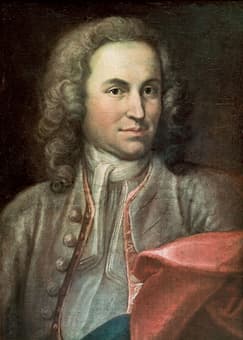
The young Bach, Weimar, 1715
While we can certainly hear some of the similarities of structure and tonal organization, how did Bach actually got his hands on the Albinoni scores? Two possible scenarios have been suggested. In the autumn of 1717 Bach traveled from Weimar to Dresden. The crown prince of Saxony had recently returned from an extended journey to Italy, having spent almost one year in Venice. One of the musicians from the Dresden Court, Johann Georg Pisendel had accompanied the crown prince on his travels, and he became good friends with Vivaldi and Albinoni. Pisendel did make copies of Albinoni’s Op. VII and brought the music to Dresden. We might rightfully assume that the oboist of the Dresden Hofkapelle, Johann Christinan Richter took a close interest in these oboe concertos, and “Bach could certainly have come in contact with certain Albinoni concertos during his stay in Dresden.”
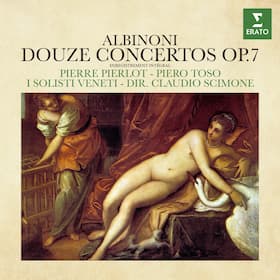
Albinoni’s Concertos Op. VII
We don’t know if Bach made copies of the works he encountered in Dresden, but we do know that he made a trip to Berlin 1719. He was on a mission to take delivery of a new harpsichord for court at Cöthen, and he spent much time and money buying the latest chamber works in circulation. “Albinoni’s Opus VII concertos may well have been among many acquisitions of printed music. There is no concrete source evidence, but it seems unlikely that Bach came in contact with the Albinoni collection much before the fall of 1717, given the collection’s relatively recent publication date and the rate of transmission of Amsterdam prints to Central Europe.”
The mature concertos of Albinoni “were an important factor in Bach’s approach to the genre throughout the decade of the 1720s. Albinoni was certainly not the only influence on Bach’s concertos from this period, but he must be counted among the chief influences. His extended opening ritornellos, his use of formal and structural elements derived from an Italianate vocal style of writing for the soloist seems to have greatly appealed to Bach.”
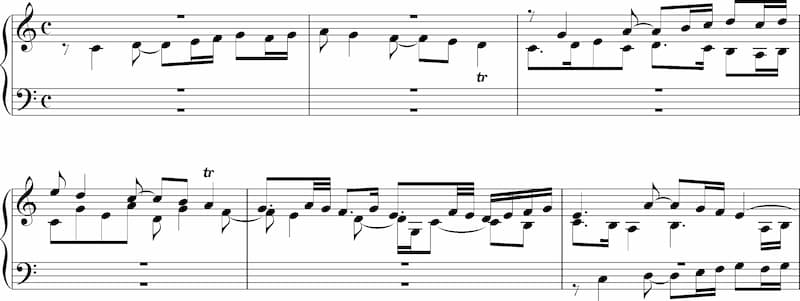
J.S. Bach: Fugue in C major, BWV 946
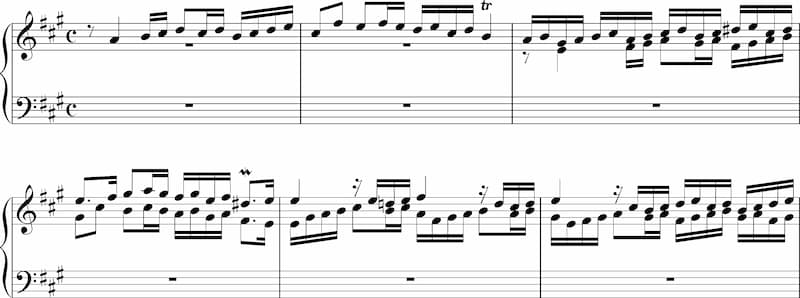
J.S. Bach: Fugue in A major, BWV 950
While the close connection between Albinoni’s Op. VII and Bach’s Brandenburg’s rely on careful stylistic, formal and harmonic analysis, an immediate connection is found in four keyboard fugues with subjects taken from Albinoni’s Op. 1. In BWV 946, 950, 951, 951a we find Bach mastering a new style and maturing as a composer. While some scholars find “facile note-spinning and pointless harmonic meandering among other weaknesses,” others “give Bach credit for tackling rhythmically difficult subjects in a variety of two-, three-, and four-part textures during his teenage years.” In BWV 950, Bach quotes directly from the Albinoni original at two points beyond the subject itself. However, Bach does not merely quote the passages but expands and transforms them to become pillars of the formal structure. A critic writes, “Bach’s scholarly engagement with Albinoni taught him to bring the fugue to a convincing conclusion without a thematically irrelevant coda.”
Friday, April 4, 2025
Making the Piano the Orchestra: Florian Noack’s Transcriptions
by Maureen Buja
Doing transcriptions, particularly for the piano, is more than just writing the same notes for a different instrument. Each instrument has its idiosyncratic elements, be it only being able to play one or two notes at the same time or being able to play 10 notes at a time. Some composers add their own characteristics, such as in the Liszt transcriptions of Schubert songs, and other transcriptions have to subtract music, such as when reducing a full orchestral work to one for string quartet.
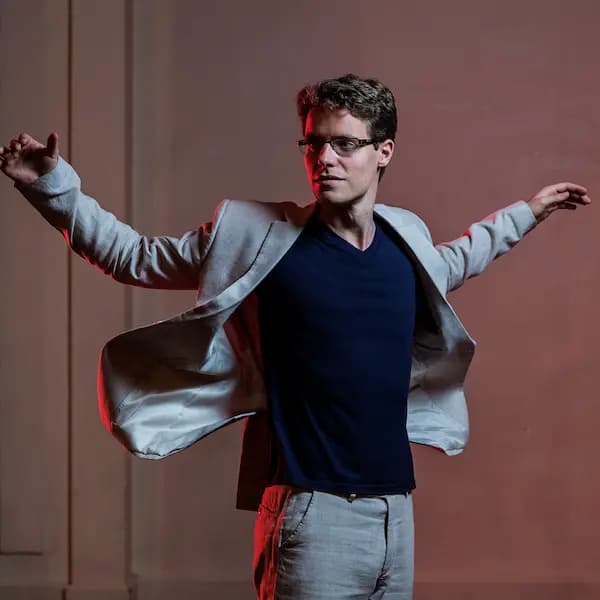
Florian Noack, 2019 (photo by William-Beaucardet)
Belgian pianist Florian Noack has taken transcription a different way. He was intrigued by looking at Bach’s Concerto for Four Harpsichords, BWV 1065, which was in itself a transcription of Vivaldi’s Concerto for Four Violins, RV 580. Bach assigned to the harpsichords the role of soloist that Vivaldi had given to the strings, reversing the roles of the instruments. Noack gave himself the challenge of now making a transcription for a single piano. The 40 fingers available to Bach’s harpsichordists is now reduced to just 10 fingers for Noack. In looking at what Bach did to Vivaldi’s music, showed him that ‘the same work can exist under several different identities’.
When he took up Rimsky-Korsakov’s Scheherazade, Noack was faced with reducing Rimsky-Korsakov’s dazzling and colourful orchestration that evoked the mysteries of the East with the sounds of a European piano. The Orient of Rimsky-Korsakov’s imagination was condensed by Noack but without losing either the distinct sound of the work or losing its story-telling qualities.
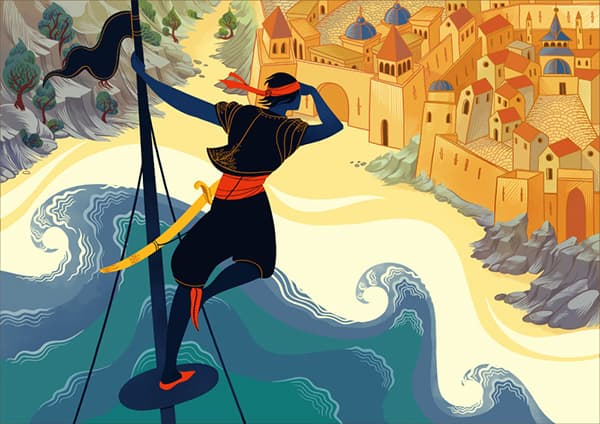
Sindbad and his ship, 2016 (illustration by Maria Surducan)
Noack uses the elements that made the pianoforte the ground-breaking innovation in music: the dynamics of loud (a roaring opening) and soft (the following rubato, pensive melody). As a soloist, he has the freedom to alter his tempos at will (something an orchestra cannot do, despite the conductor), and he uses that to bring out the vagaries of the sea and Sinbad’s voyage.
In the rest of the album, we have music from Tilman Susato and Bach to music for a Disney film. Noack opens the album with the Bach transcription we discussed above and follows that with Mendelssohn’s The First Walpurgis Night, Op. 60. Sheherazade follows. A Paraphrase on Various Waltzes by Johann Strauss II formed by the memory of the Vienna New Year’s Concerts and opens with an imagined waltzing figure on a music box coming to life. The 1551 Danserye of Tilman Susato follows, with three transcriptions. Sergei Prokofiev’s Classical Symphony No. 1 is brought to the keyboard, as is Shostakovich’s Waltz No. 2, originally written to accompany the 1956 Soviet film The First Echelon.
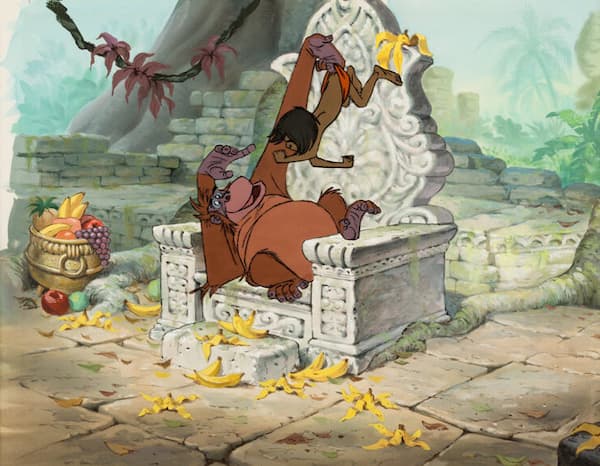
Disney: The Jungle Book: King Louie and Mowgli, 1967
Noack closes his album with a surprise, the Sherman Brothers’ song I Wanna Be Like You. Written for Louis Prima, the New Orleans trumpeter and entertainer, who provided the voice for the orangutan King Louie in Disney’s film The Jungle Book (1967), the song is full of New Orleans jazz styling; Noack’s transcription takes up the ‘complexity, polyrhythms, and idiom’ of the music and makes it his own.
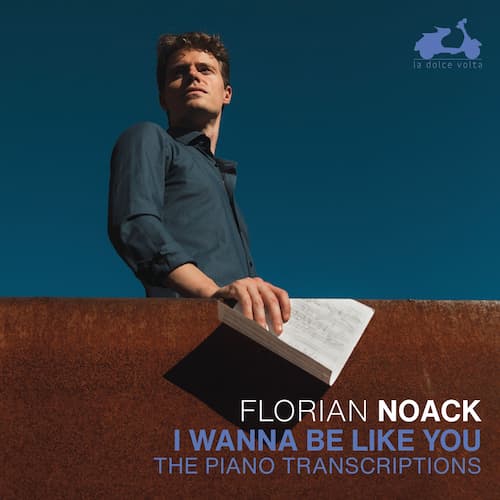
Florian Noack: I Wanna Be Like You – The Piano Transcriptions
La Dolce Volta, LDV 121
Release date: 8 March 2024
Official Website
Saturday, March 29, 2025
Wednesday, September 21, 2022
Famous Music Composers New York
by Hermione Lai, Interlude
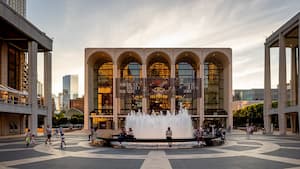
Lincoln Center
In 1944, Leonard Bernstein wrote music for the musical On the Town. It tells the story of three sailors on shore leave for their 24 hours of adventures and romance in New York City. The song “New York, New York,” with lyrics by Betty Comden and Adolph Green features the well-known line:
New York, New York, a helluva town
The Bronx is up but Battery’s down.

New York City
For the 1949 MGM film the word “helluva” was changed to “wonderful” to protect delicate sensibilities. I’ve been to New York a couple of times, and it is still a helluva town. There is around the clock excitement including Broadway shows, museums, historical attractions, and some of the best restaurants on the planet. And for every lover of classical music, there is no better place to visit than Lincoln Center to catch the NY Philharmonic, the Metropolitan Opera, the New York City Ballet, the Juilliard School of Music; in all 11 resident arts organizations presenting music, theater, dance, film, opera and artists from across the globe. Did I already mention Carnegie hall? The city of New York was, and still is, home to countless famous music composers, so I decided to write a blog on celebrated composers either born in New York or famously active in that city.
Leonard Bernstein
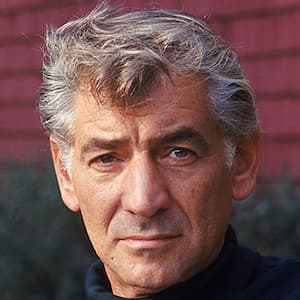
Leonard Bernstein
Talking about Leonard Bernstein, although he was born in Massachusetts, he made NYC his permanent home. He lived in various apartments in Manhattan, and as the first American-born conductor of a major American symphony orchestra, he led the New York Philharmonic to world fame. It is no surprise that his most popular musical for Broadway, West Side Story, is set in the Upper West Side of Manhattan in New York City.
George Frederick Bristow
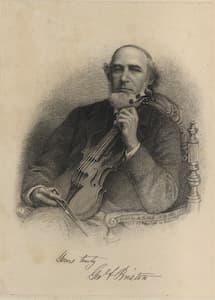
George Frederick Bristow
Leonard Bernstein is considered “one of the most prodigiously talented and successful musicians in American history,” but famous music composers of New York can be traced back to the middle of the 19th century. George Frederick Bristow was born in the New York borough of Brooklyn on 19 December 1825. Musically precocious, he started his professional career as a violinist at the age of 13 and played first violin with the New York Philharmonic SO from 1843 to 1879. Bristow was also active as a conductor, and he led the New York Harmonic Society (1851–63) and the Mendelssohn Society (1867–71) in performances of large choral and orchestral works. I read that Bristow attempted to establish a “native style in American art music.” As such, we frequently find American titles or textual content in his compositions, for example, “Rip Van Winkle” “The Great Republic” “Columbus” and “The Pioneer.” Nationalist titles aside, scholars write “his music was typically European in style, reminiscent of the music of Mendelssohn.” In all, Bristow appears to have written 135 compositions, and on the strength of this output alone, he should certainly be considered one of the famous music composers of New York.
George Gershwin
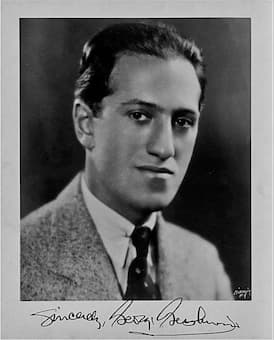
George Gershwin, 1935
The best-known and most famous music composer of New York is undoubtedly George Gershwin. Born in Brooklyn, he grew up on New York’s Lower East Side, and at the age of 15, he already worked for the Tin Pan Alley music-publishing firm of Jerome H. Remick & Company as a song plugger. Basically, that means he was engaged as a salesman to promote the firm’s songs by playing and singing them for performers. In 1918 he signed a contract with Thomas B. Harms Music Publishing Company, a firm that eventually published over 90 percent of all Broadway songs. Gershwin lived the American dream, and since he composed sometimes up to 6 songs a day, he made a financial killing. “For the longest time,” as he later wrote in life “I wanted to work at big compositions” and within a couple of years, he developed from a songwriter into a composer. Gershwin “primarily synthesized and utilized elements of many styles, including the music of New York’s Yiddish theatre, vaudeville, ragtime, operetta, jazz, Tin Pan Alley and Broadway songs, the music of the Gullah people and the impressionist and post-Romantic music of European composers.” Intimately connected with New York City, his Rhapsody in Blue and the Concerto in F “ brought jazz music into the concert hall.”
John Zorn
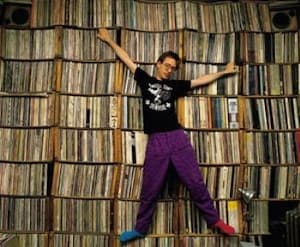
John Zorn
The metaphor of calling New York City a melting pot dates from the beginning of the 20th century. Then as now, it is home to a unique diversity of people, and over 800 languages are spoken throughout its 5 boroughs. That kind of diversity is expressed in glorious food, areas of different religions and cultures, and music. Currently, a Manhattan-based scene that is sometimes called “New Music” has emerged. As a contemporary musical stream, its composers are strongly influenced by minimalism and the various musical styles of the community. John Zorn, born in New York City, writes about his compositions. “All the various styles are organically connected to one another. I’m an additive person—the entire storehouse of my knowledge informs everything I do. People are so obsessed with the surface that they can’t see the connections, but they are there.” Reminiscent of Gershwin’s eclecticism, Zorn uses avant-garde and experimental approaches to composition and improvisation, “inclusive of jazz, rock, hardcore, classical, contemporary, surf, metal, soundtrack, ambient, and world music.” Zorn explains, “I write in moments, in disparate sound blocks, so I find it convenient to store these events on filing cards so they can be sorted and ordered with minimum effort. Pacing is essential. If you move too fast, people tend to stop hearing the individual moments as complete in themselves and more as elements of a sort of cloud effect… I worked 10 to 12 hours a day for a week, just orchestrating these file cards.” Critics have called Zorn “one of the most influential musicians of our time,” and he is certainly one of the famous contemporary music composers of New York.
Edward MacDowell
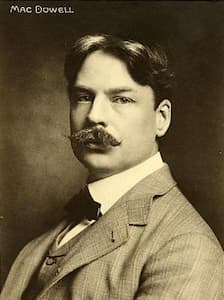
Edward MacDowell
Although he spent the majority of his professional life in Boston, Edward MacDowell was born in New York City. Coming from a Quaker background, young Edward showed great talent for drawing and music at an early age, and he started piano and violin lessons at the age of 8. Destined for greatness, his mother took him to Paris to attend the Conservatoire, but he soon left for Germany to study composition with Joachim Raff. We also know that he played for Franz Liszt at conservatory concerts, and that the great virtuosos recommended some early MacDowell compositions for publication by Breitkopf & Härtel. Returning to the United States, MacDowell and his wife lived in Boston from 1888 to 1896, from then on in New York until his death in 1908. MacDowell described “music as a language, but a language of the intangible, a kind of soul language.” While the romantic tradition in music never lost its relevance and importance, MacDowell eventually began using elements of American folk music in his compositions, and “his two piano concertos are described as the “most important works in the genre by an American composer other than Gershwin. His first piano concerto premiered in New York in 1888, and he returned the following year to premiere his second.
William Schuman
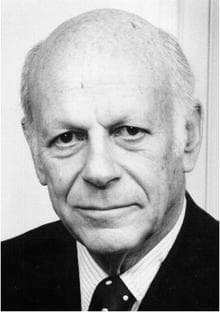
William Schuman
When it comes to performing arts education, the Juilliard School in New York City is considered one of the best drama, music, and dance schools in the world. Founded by Frank Damrosch, the godson of Franz Liszt in 1905, the conservatory quickly convinced American musicians that they did not need to go abroad for advanced study. In 1945, composer William Schuman expanded the school’s curriculum by establishing a Dance Division under the direction of Martha Hill and he also established the Juilliard String Quartet “alongside a groundbreaking music theory curriculum.” Schuman was born in Manhattan and later enrolled at New York University to pursue a business degree. He already dabbled in composition when on 13 April 1930 he attended a Carnegie Hall concert of the New York Philharmonic, conducted by Arturo Toscanini. Schuman later said of that experience, “I was astounded at seeing the sea of stringed instruments, and everybody bowing together. The visual thing alone was astonishing. But the sound! I was overwhelmed. I had never heard anything like it. The very next day, I decided to become a composer.” While Schuman’s recollections of events might not have been entirely accurate, he did become one of the famous music composers of New York. Schuman won the inaugural Pulitzer Prize for Music in 1943 for his Cantata No. 2 “A Free Song,” and conductor Leonard Slatkin wrote, “Schuman is the man who may eventually emerge as the great American symphonist.
Marion Bauer
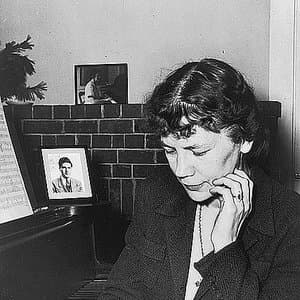
Marion Bauer
Marion Eugénie Bauer was born in Washington, but showing an early aptitude for music, she moved to New York City to focus on a career in composition. She met the pianist Raoul Pugno, and he invited Bauer to study with him in Paris in 1906. In turn, Bauer became the first American to study with Nadia Boulanger. For the next decade Bauer moved between New York City and Europe, but in September 1926 she was hired as instructor, and later professor, at the New York University music department, becoming the first female music faculty. She taught classes in composition, form and analysis, aesthetics and criticism, and music history and appreciation. As a composer, Bauer wrote for piano, chamber ensemble, symphonic orchestra, solo voice, and vocal ensembles. Always an advocate of contemporary music, her own compositional voice is considered relatively conservative, featuring plenty of impressionistic and romantic influences in her works. Following a concert exclusively devoted to her music in New York Town Hall in 1951, a critic writes, “The music is prevailingly contrapuntal, and dissonance is not absent. Yet the fundamental concept is melodic, the thinking clear and logical, the sentiment sincere and direct.”
John Corigliano
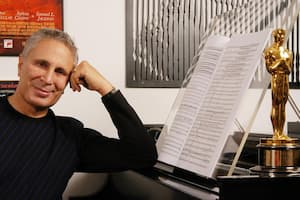
John Corigliano
John Corigliano was born in New York City in 1938, son of John Corigliano Sr., the concertmaster of the New York Philharmonic for 23 years. He studied at Columbia University, worked as a music programmer and music director for New York City radio stations, and worked as an assistant to the producer on the Leonard Bernstein “Young People’s Concert.” Corigliano achieved international recognition by winning the chamber-music competition of the Spoleto Festival in Italy with a Sonata for Violin and Piano. He soon collaborated with mainstream musicians and institutions, and “his oft-stated commitment to intelligibility and his mostly tonal early works have sometimes obscured the extent of his technical range and his often daunting progressivism.” To be sure, Corigliano is an eclectic composer who is not afraid to use many styles in his writing. “He is also a colorist,” according to a conductor, “as he is able to use whatever instruments and vocal forces he has at hand to create new sound worlds.” He has won a Pulitzer, an Oscar and five Grammys, and he explains “When I was writing my early pieces, I did it in a hyper way because for me, composing was such a nerve-racking thing to do. Now, the whole note is my friend; an adagio is what I look for.”
Elliott Carter
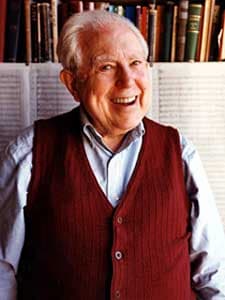
Elliott Carter
Elliott Carter, born in New York City, is one of the most famous music composers of the second half of the 20th century. His compositions are performed throughout the world, as his musical language combines elements of European modernism and “American ultra-modernism in a distinctive style of surging rhythmic vitality, intense dramatic contrast, and innovative facture.” He studied at Harvard and subsequently with Nadia Boulanger, and upon his return to the United States, he settled in New York. In his Cello Sonata, Carter was looking to “re-examine all aspects of music in order to achieve an emancipated musical discourse, in which a new rhythmic texture brought with it a harmonic language, establishing a new emotional intensity and breadth, and giving his music an epic quality.” Carter held teaching positions at the Peabody Conservatory (1946–8), Columbia University (1948–50), Queens College, CUNY (1955–6), Yale University (1960–62), MIT, and Cornell University (from 1967). His one long-term teaching position was at the Juilliard School (1964–84). His numerous honors include two Pulitzer Prizes (1960, 1973), the Sibelius Medal (1961), the Gold Medal of the National Institute for Arts and Letters (1971), the Ernst von Siemens Prize (1985), the National Medal of the Arts (1985), the Gold Medal of the Royal Philharmonic Society (1996), the Prince Rainier Foundation Music Award (1998), and induction into the Classical Music Hall of Fame (1998).
Aaron Copland
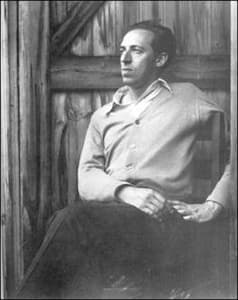
Aaron Copland, 1933
In this little blog, it is of course impossible to describe in detail the countless famous music composers of New York, but I might at least mention William Fry, Charles Griffes, Leo Ornstein, Rubin Goldmark, Rogger Sessions, Gunther Schuller, Leon Kirchner, Bernard Herrmann, Meredith Monk, Laurie Anderson and a whole crop of young and exciting composers either born or calling New York home. It might be fitting to close with the “Dean of American Composers” Aaron Copland, born in the borough of Brooklyn on 14 November 1900. One of America’s greatest contemporary composers, he was able to capture the American experience with works that have an immediate appeal. As he wrote, “I no longer feel the need of seeking out conscious Americanism. Because we live here and work here, we can be certain that when our music is mature it will also be American in quality.” Copland had long felt an increasing dissatisfaction with the relations between the music-loving public and the living composer. He wrote, “It seemed to me that we composers were in danger of working in a vacuum.” He quickly realized that the radio, phonographs, and film scores were actually creating contemporary music. “It made no sense to ignore them and to continue writing as if they did not exist. It was worth the effort to see if I couldn’t say what I had to say in the simplest possible terms.” To me, Aaron Copland is simply a legend, and certainly one of the most famous music composers of New York.
Thursday, October 17, 2019
Boy who blurted out ‘Wow!’ in concert...
... invited back as a special guest
By Rosie Pentreath, ClassicFM
0
 |  |  |
Nine-year-old Ronan Mattin, who went viral earlier in the year for exclaiming ‘wow’ after some magnificent Mozart at Boston’s Symphony Hall, has been invited back by the orchestra.
Back in May, the story of a nine-year-old boy who couldn’t hide his enthusiasm for Mozart went viral.
Now dubbed the “wow child”, young Ronan Mattin exclaimed “wow” loudly in the silence before the applause at the end of The Handel and Haydn Society’s performance of Mozart’s Masonic Funeral Music, and delighted audiences around the world.
Mattin, who is on the autism spectrum and is “obsessed with musical instruments”, was invited by the orchestra to return to Boston’s Symphony Hall and attend a dress rehearsal as a special guest.
He left school early for the visit and was accompanied by his grandparents, according to The Boston Globe.
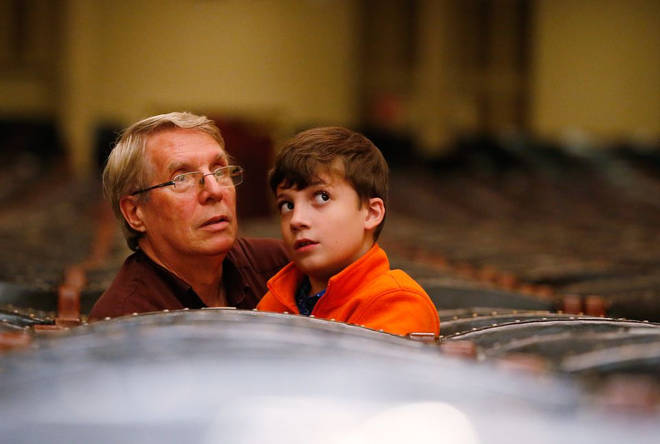
A witness to the first dress rehearsal in the season of The Handel and Haydn Society’s ‘A Mozart Celebration’ season, Mattin was apparently said few words during his visit, but was “thrilled”.
“He was tapping the window and jumping up and down,” his grandmother, Claire Mattin, told The Boston Globe.
“Yeah, music,” were two of the boy’s well-chosen words. Inside the hall he got the chance to meet instruments and their players up close, and hear the sounds they make in isolation.
Principal Trombonist, Toby Oft, welcomed Mattin to experience the vibrations of the music he was making, explaining “sound is vibrations.”
Ronan’s enthusiasm for music came to global attention when, during a brief moment of silence after The Handel & Haydn Society finished their Mozart, he called out an uninhibited ‘Wow!’ (watch video above).
The awe in his voice made the whole audience and ensemble erupt into laughter and applause, with the orchestra’s CEO David Snead describing it as “one of the most wonderful moments I’ve experienced in the concert hall”.
After the concert, the orchestra began looking for the child – and his grandparents eventually got in touch, after initial hesitation due to concerns of reproach.
The moment went viral as a sheer demonstration of the power of music, and the importance of any appreciation of it being allowed to ring loud and clear in the concert hall.

“These sort of moments, like Ronan’s wonderful ‘wow’ moment, are just electrifying for us, and actually just make us realise exactly what we’re here doing,” the orchestra’s Artistic Director, Harry Christophers, tells The Globe.
“We’re here to give people a release from their daily existence,” Christophers continues. “With Ronan, it’s spontaneous, it’s an innocence, it’s just lovely.”
Hear, hear!
Subscribe to:
Comments (Atom)
